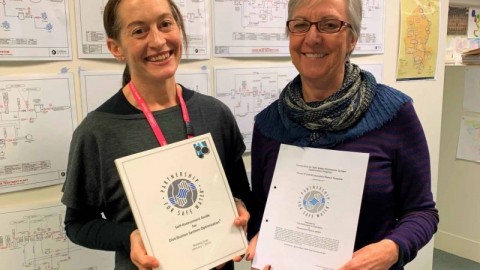By Cassandra Hogan, National Sector Leader Power & Utilities, KPMG and Mark Johnston, Associate Director Power & Utilities, KPMG
Reflecting on the energy network utility, and particularly the opposing challenges of maintaining an infrastructure rich environment while adapting to a changing technology landscape, it can be useful to draw from the experience of other sectors. For utilities, there are useful parallels with the defence sector, particularly when it comes to asset management and agility.
In considering the utility of the future, other frames of reference can provide useful lessons to better understand and communicate the challenges and strategies for navigating the new utility paradigm.
While it is easy to understand the need for defence to be agile to keep pace with the highly competitive and sometimes deadly landscape, until recently the drivers in the utility sector have been very different.
In each of the states of the national electricity market, the gradual infrastructure build over the last 100 years to support growing state economies required a focus on the fundamentals of supplying the market – reliability and security.
This mantra, and its translation into infrastructure, shaped the culture of a sector heavily dominated by engineers.
It is worth considering that defence, too, is heavily reliant on assets and infrastructure. The 2016 Defence White Paper, for example, signalled arguably the most significant capital investment program in defence in more than a generation: buying new submarines, surface ships, fighter jets, armoured vehicles and information technology.
A challenge for defence is to manage this infrastructure renewal process while also adapting to an increasingly changing, technology rich landscape. These investments need to be undertaken in a way that offers maximum flexibility in adapting to new competitive environments.
The electricity sector is also undergoing significant disruption from a changing landscape.
These changes include increased access to alternative energy supplies, where customers with solar panels represent an estimated fourteen per cent of all Australian households in 2014; the adoption of energy storage; the introduction of metering contestability for small customers from 1 December 2017; the entry of some electricity distributors into the energy services market; and changing residential customer expectations arising from digital and personalised buying experiences in other industries.
Establishing a frame of reference
In looking to another sector for lessons, in this case defence, it is first necessary to establish the frame of reference – where are the similarities, and what techniques or methods have been applied to overcome similar issues.
Defence and utilities are similar in the following areas:
Assets and infrastructure. Both sectors invest large sums in procuring equipment, developing infrastructure and sustaining assets throughout their lifecycle.
Technology. Technology developments, new processes and competitive forces are causing disruption to both sectors. Careful thought is required towards investments in assets to minimise the expense of stranding assets.
Competition. Changes in the competitive landscape are causing decision makers to re-think investments, to understand where they should be positioned relative to their competition and where new opportunities may lie through a more agile approach.
Customers. Utility customers include large and small consumers, those who represent consumers, i.e. the retailers, and the generation sector whose product utilities transport to the consumer.
In defence, the customer, quite simply, is the war fighter using the assets and processes developed to prosecute orders distilled from government direction.
The parallel between the sectors is that a focus on the needs and wants of customer(s) is essential to keep and maintain a competitive edge within the environment. In both environments, finding ways to cost-effectively meet and exceed customer’s expectations is essential in retaining their confidence.
For utilities, shifting customer expectations have already created new opportunities for electricity networks to enter the competitive energy services market.
This opportunity moves beyond the network to building residential customer brand loyalty through multiple potential touch points with the customer.
For example, outage restoration and vegetation management has the potential to be leveraged into a customer engagement opportunity, giving an advantage over other market participants.
In this regard, the Australian Energy Regulator (AER) will issue in November 2016 ring-fencing guidelines to separate the competitive and regulated parts of network businesses in order to support the development of competitive markets for energy services.
By 2020, the internet of things, combined with rapid technological advancement integrating the smart home with home generation in home energy management systems, will have a significant impact on changing customer expectations. Expectations will only continue to mature.
These opportunities have been noticed by nonutility industry companies, who have started to enter the market from multiple angles, creating the next race to own the energy services customer relationship, and through that to control who has access in the future to multiple profit opportunities beyond the power commodity.
Who will win the next race for the energy services customer?
Keys to success
For electricity networks, the key to being successful in this changing and disruptive environment is to ensure agility concepts and agile processes are built into business strategy, business model, operating model, organisational culture, supply chain and transformation initiatives.
In understanding the application of agility in utilities, looking at the defence frame of reference offers some insights as follows:
Market awareness. Defence is relentless in understanding developments that impact on the success of their mission. Information requirements are defined and information sources queried to develop a continuously evolving understanding over several time horizons.
For utilities, a high level of market awareness has never been more important. Developing a mindset to be inquisitive, challenge perceptions and paradigms and then to actively understand the environment will set successful utilities apart from others.
You cannot compete in a market you know nothing about, or presume to understand, so do the homework with an open mind.
A change in the market can originate from government or regulatory changes, new technology or processes, competitor behaviour or customer demands.
Staying attuned to all of these, and being in a position to shape the outcome, will put the proactive utility in the best position to succeed.
Decision cycle time. Through flatter and more flexible operating models and well-rehearsed decision making processes, the agile utility will be able to respond to changes in the market faster, and with greater precision, than competitors.
Defence, too, trains relentlessly to test decision making processes, reduce decision cycle times and ensure impacted stakeholders understand their responsibilities and actions under defined conditions.
Defence, like utilities, understand the lead time to implement decisions and plan accordingly. A challenge for utilities is to apply this framework to non-traditional areas.
Feedback loops. Decision makers in defence cannot prosecute a mission if they don’t know what is happening at the front line.
Defence works hard to ensure a flow of information is maintained at all costs with the customer, i.e. the army units, aircraft and naval assets in the field.
For utilities, a new challenge is to develop a customer and stakeholder sentiment and engagement system, be that a net promoter score, complaints handling and/or other systems to understand what customers are saying and feeling about the service they are receiving.
Customers, like soldiers on the ground, can be an invaluable source of information on competitor products, or even what other sectors are doing that may apply to the utilities strategy.
Innovation and technology. History is riddled with military failures of a superior force to an inferior opponent. The story of David and Goliath is illustrative of the superior use of technology by an apparently inferior combatant.
Investing and using technology in innovative ways are key points of differentiation for successful utilities.
Leadership, culture and reward. Competent leadership is a prized asset within defence as it is widely known that good leaders are able to get the best out of his or her people.
Recognising success, or even recognising failure, can be an important way of motivating people and shaping culture.
Recognition in defence is usually not in a financial sense; think medals and commendations. Defence prides itself on an innovative culture; making do with what is available at the time to solve a problem.
Developing a culture of innovative thinking is critical so that all levels in the organisation are aware that their ideas contribute to the utilities strategy and are valued.
Delegating responsibility for decision making as far down or as far forward is also a key to success in the agile utility, as it is in defence.
Adapting to change
Like defence, to take advantage of changes in the market environment, a transformational program is often required. The sorts of actions that management can take to become better prepared and more successful in such an uncertain environment include:
Breakdown the business into its most basic functions and markets. Understand the key element of the business. Defence does this in a range of ways, from separation of the services into army, navy and air force, through to a structured framework for allocating roles in a headquarters to ensure smooth operations.
For the utility, understanding the various elements of the business, their roles, inputs, outputs and processes help to better understand the potential impact of external forces.
Assess transformational forces. Understand how they impact strengths, weaknesses, opportunities and threats associated with each function and the overall enterprise, especially as it relates to the key elements of your core business.
Defence has structured planning processes that ensure all factors are considered and decision (contingency) triggers are known well in advance. This promotes understanding and communication.
For the agile utility, broad understanding of the business, and wider market environment, assist in the transformational planning process. Using a consistent approach to planning and communicating at all levels will improve planning quality and the communication of the outcome.
Leverage scenario analysis. Use it to stress test business strategies for each of the functions and the overall enterprise. Defence employs tools like simulation, mentoring and war gaming that brings together all functions and considers the input of each and the impact of their decisions on others.
In a changing environment for utilities, using similar tools and approaches to Defence will ensure that plans are challenged for their resilience as well as their adaptability to future developments.
Refresh your strategy. Learn from observation and adapt those lessons into new thinking. Defence maintains a strategy group at the highest level and regularly refreshes its thinking to suit the changing environment.
For new and existing capability, defence also designs target business and operating models for each of the key functions and capabilities. As potential new capabilities are added to the utility, these need to be well understood and designed before implementation including how they will interact with other business functions.
Develop and prioritise a roadmap for transformation. Utilities need improvement initiatives that drive the enterprise and key functions toward optimal target operating models. This may be akin to the Defence White Paper that takes a high level view across the defence portfolio.
Furthermore, there are a range of sub-initiatives generally working towards improved capability. For the utility, a defined transformation roadmap that delivers the strategy, but that is also agile in its implementation approach, offers a structured approach to delivering the business change.















